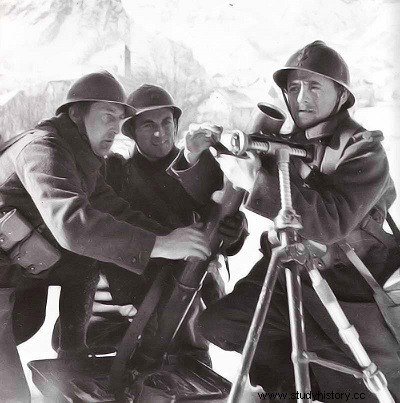
Features
Country:France
Brandt 81 mm mortar mle 27/31
Calibre:81.4 mm.
Length:from barrel, 1.26 m
from bore, 1.16 m.
Weight:in action, 59.700 kg
of the barrel, 20,700 kg
of the bipod, 18,500 kg
of the base plate, 20,500 kg.
Pointing in height:+ 45° to + 80°
Pointing in direction:8° to 12° depending on elevation.
Maximum range:standard projectile, 1,900 m;
heavy projectile, 1,000 m.
Projectile weight:stan 3,250 kg; heavy, 6,900
The Stokes mortar, which appeared during the First World War, will remain the first modern example of this type of weapon, both in form and design. It was, however, very rudimentary, and was reduced to a pipe placed on a very simple support, the whole resting on a base plate responsible for absorbing the forces of recoil. Everything changed during the twenties thanks to the French firm Brandt:it subjected the original model to modifications that were not very visible (the general appearance remained the same), but profound, by redesigning the machine and equipping it with ammunition much superior. The Brandt 81mm Model 27 Mortar—it first appeared that year—was revised four years later to become the particularly handy Model 27/31.
Setting up the Stokes mortar was time consuming. Brandt's designers modified the bipod so that it could adapt to all types of terrain, while the leveling of the sighting system was done by adjusting only one of the legs of the weapon. The sights were placed very close to the muzzle of the mortar, so that the pointer could make use of them without being held above its machine, and a mechanism with screw on their fork of fixing easily allowed minimal changes of direction. The decisive modifications, however, were at the level of the ammunition. The grenades of the Stokes mortar were succeeded by projectiles with a very studied shape, carrying a greater explosive charge, and, above all, a greater range. Brandt developed a wide variety of shells for his Model 27/31, which can be divided into three main categories.
First, the standard type, breaking, then a similar machine, twice as heavy, but whose range was reduced by half; and smokers. Each of them gave rise, of course, to very many variants — the firm could, for example, supply smokes of different colors on demand.
The Model 27/31 was very successful as soon as it was put into circulation, in Europe and elsewhere. In a few years, it was everywhere produced under license, or simply counterfeited. Its caliber of 81.4 mm became the standard for all European infantry mortars; all those implemented during the Second World War owe him something, when they are not simple copies. It even eclipsed the weapons in service in Germany, the United States, the Netherlands, China or the Soviet Union.
Its influence is still felt today, although 81 mm mortars now have a range six times greater. But the excellence of its design enabled it to intervene on the battlefields of the last world war, in one form or another, and to remain in service for many years afterwards.
